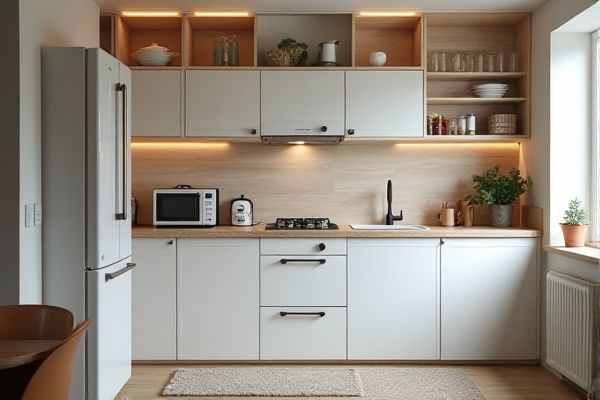
Fridge drawers offer customizable storage solutions that maximize space efficiency and improve food organization compared to traditional fridge shelves, allowing You to access items more easily without disrupting the main compartment. Explore the rest of the article to discover how choosing fridge drawers can transform Your kitchen experience.
Table of Comparison
| Feature | Fridge Drawers | Traditional Fridge |
|---|---|---|
| Storage Design | Separate pull-out drawers for organized storage | Single door compartments with fixed shelves |
| Accessibility | Easy access with slide-out drawers | Requires bending and reaching into shelves |
| Temperature Control | Often have independent temperature zones | Uniform temperature across entire fridge |
| Energy Efficiency | Potentially better due to targeted cooling | Less efficient; cools entire compartment |
| Space Utilization | Maximizes storage with compartmentalized space | Less flexible storage arrangement |
| Price Range | Higher cost due to advanced features | Generally more affordable |
| Maintenance | More complex due to multiple drawers and electronics | Simple, fewer components |
Introduction: Fridge Drawers vs Traditional Fridges
Fridge drawers offer customizable storage compartments that maintain precise temperature controls for different food types, enhancing organization and freshness. Traditional fridges typically feature fixed shelves and door bins, providing simpler, uniform cooling but less flexibility in arrangement. Your choice depends on whether you prioritize versatile storage solutions or classic fridge design for everyday use.
Space Optimization and Storage Capacity
Fridge drawers enhance space optimization by providing segmented compartments that allow for organized storage of smaller items, reducing clutter and maximizing usable space compared to traditional refrigerators. Their design often includes adjustable dividers and customizable temperature zones, increasing overall storage capacity by efficiently utilizing vertical and horizontal space. Traditional fridges typically have fixed shelves and larger open areas, which can lead to wasted space and less effective organization.
Accessibility and User Convenience
Fridge drawers offer enhanced accessibility by allowing users to pull out compartments fully, making it easier to organize and reach items without bending or digging through shelves. Traditional fridges often require reaching into deep shelves, which can be inconvenient and limit visibility of stored food. Drawer-style storage improves user convenience through segmented compartments that reduce clutter and enable quicker access to frequently used items.
Energy Efficiency Comparison
Fridge drawers offer improved energy efficiency by minimizing cold air loss when accessing specific compartments compared to traditional fridges with single large doors. These drawers are designed with targeted cooling zones, allowing better temperature control and reducing energy consumption by maintaining optimal conditions only where needed. Your energy bills can decrease as fridge drawers prevent frequent temperature fluctuations, enhancing overall appliance efficiency.
Design and Aesthetic Differences
Fridge drawers offer a sleek, modern design that integrates seamlessly into contemporary kitchens, providing easy access and a streamlined look compared to traditional fridges with hinged doors. The horizontal drawer layout maximizes space utilization and enhances organization, often featuring clear fronts to quickly identify contents without opening. Traditional fridges tend to have a more utilitarian design, with larger door panels and less focus on seamless cabinetry integration, which can impact the overall kitchen aesthetic.
Temperature Control and Freshness
Fridge drawers offer precise temperature control, allowing you to store different foods at optimal temperatures to maintain freshness longer compared to traditional fridges with a single cooling zone. These drawers often come with adjustable humidity settings that help preserve the texture and flavor of fruits, vegetables, and meats more effectively. Your ability to customize conditions within fridge drawers leads to reduced spoilage and better overall food quality.
Installation and Maintenance
Fridge drawers offer easier installation with slide-in compartments that fit seamlessly into kitchen cabinetry, reducing the need for extensive modifications compared to traditional fridges. Maintenance of fridge drawers is simplified by removable bins and accessible components, allowing for straightforward cleaning and repairs. Your choice between these options can affect both the convenience of setup and long-term upkeep efficiency.
Cost Analysis: Initial and Ongoing Expenses
Fridge drawers typically have higher initial costs compared to traditional fridges due to their advanced design and customizable compartments, often ranging from $1,500 to $3,000 or more. Ongoing expenses may include increased energy consumption and potential maintenance for mechanical sliding mechanisms, whereas traditional fridges usually incur lower repair costs and reduced energy usage with simpler components. Your choice impacts long-term affordability, as traditional models tend to offer more budget-friendly operation, while fridge drawers provide convenience at a premium price.
Best Use Cases for Each Type
Fridge drawers excel in multi-zone cooling, allowing you to store different types of food at their ideal temperatures, perfect for meal prepping and frequent access to snacks, beverages, or deli items. Traditional fridges offer larger overall storage capacity and flexible shelving, making them ideal for families or those who shop in bulk and require ample space for fresh produce, large containers, and leftover meals. Choosing between the two depends on your lifestyle, with fridge drawers suiting organized, space-efficient storage needs and traditional fridges catering to comprehensive, versatile cold storage.
Final Verdict: Which is Right for Your Needs?
Fridge drawers offer specialized storage with easy access and customizable temperature zones, ideal for users prioritizing organization and energy efficiency. Traditional fridges provide larger overall capacity and versatile shelving, better suited for households needing expansive storage for varied items. Your choice depends on whether convenience and targeted storage or maximum space and flexibility better align with your daily food management.
 homyna.com
homyna.com